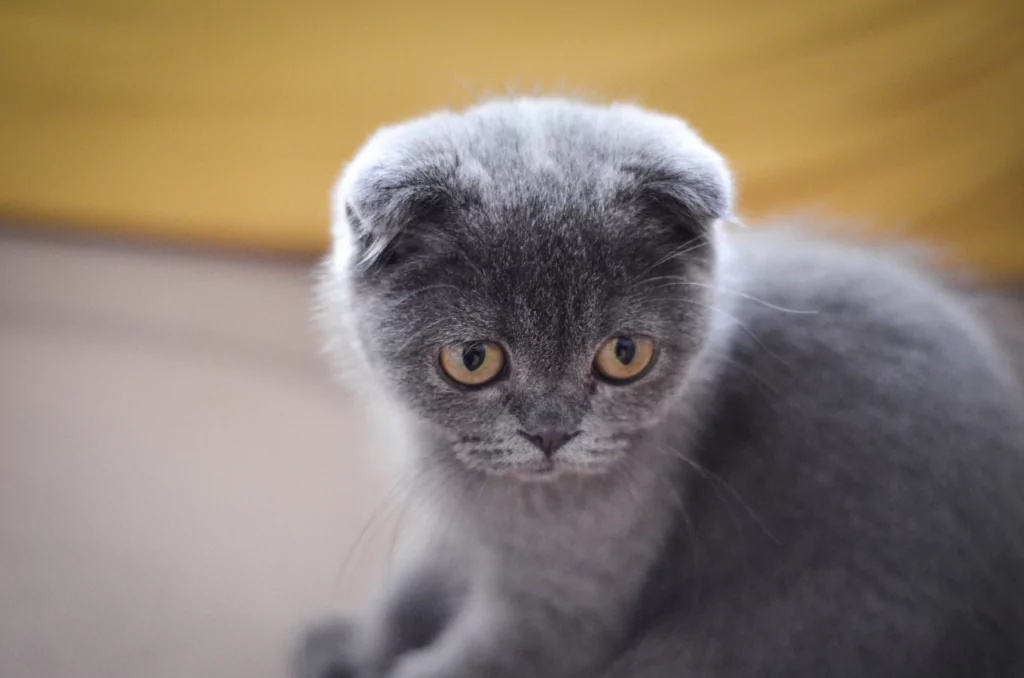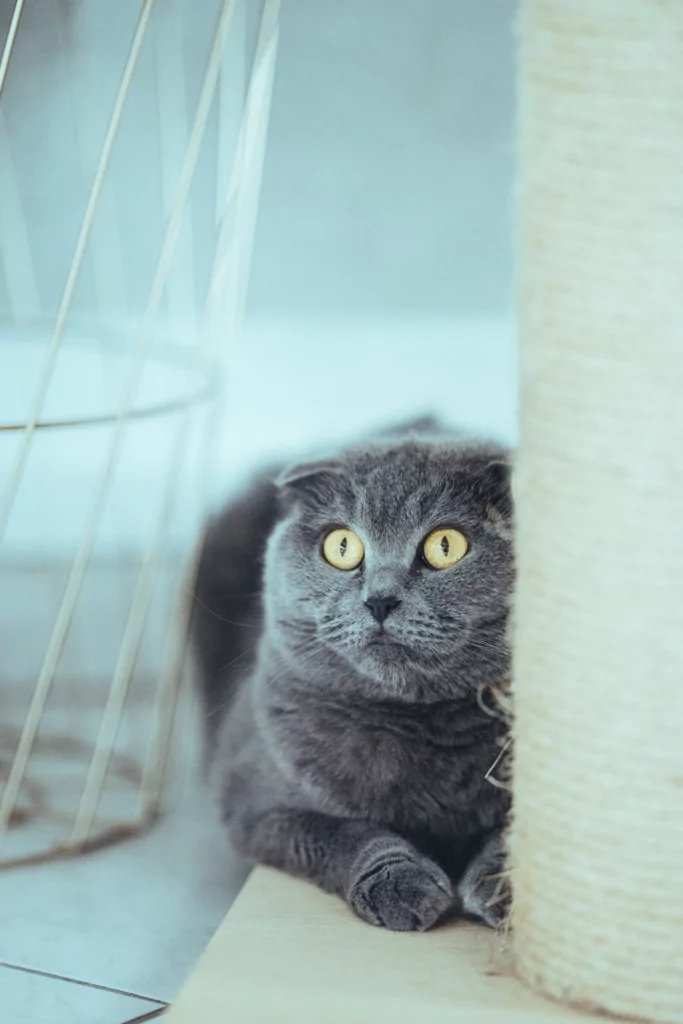
Friendly & Prohibited: Everything About the Scottish Fold

A Scottish Fold is recognized by its folded ears. Adorable to look at, but it’s not that simple. This cat breed is selectively bred for physical traits that result in a lot of pain and discomfort. Read all about this prohibited breed here.
In this blog:
- The Origin of the Scottish Fold
- The Appearance and Coat of the Scottish Fold
- The Character of a Scottish Fold
- Diseases and Conditions of a Scottish Fold
- How Long Does a Scottish Fold Live?
- Caring for a Scottish Fold
- Buying a Scottish Fold (Kitten)

The Origin of the Scottish Fold
This breed was first observed in Scotland in the early 1960s. Even back then, this cat breed had the distinctive fold in the middle of its ears. This fold is caused by a condition known as Osteochondrodysplasia, an abnormality in the cartilage of cats. Partly because of this, this cat breed was not admitted to cat shows, and the registration of this breed was revoked in 1971.
To this day, Scottish Folds are not recognized by breed associations. The breed is also banned in Europe. Fortunately, because these cats are not healthy and often suffer pain. If you want to know more, keep reading, as we’ll provide further information under “diseases and conditions.”
The Appearance and Coat of the Scottish Fold
According to the standard, this cat breed can come in various colors, except for chocolate, colorpoint, and lilac. The coat is short but thick and plush. Scottish Folds have a stocky and muscular build, and they are of average size. The legs, when the cat is healthy, are of normal length, and the tail is also regular in length. The paws are round and compact.
The head of a Scottish Fold is round, with rounded cheeks and a rounded forehead. The chin is firm, the ears are very small and folded forward. Furthermore, the eyes are moderately spaced, round, and can be of any color.

The Character of the Scottish Fold
This cat breed has many health issues, but it still possesses a delightful character. Scottish Folds are playful, social, and enjoy hunting. They love cuddling but can also be quite active. If you have a Scottish Fold, make sure you have a stable cat tree at home to help them release their energy. Additionally, Scottish Folds are incredibly friendly and gentle, making them perfect cats for families.
Fun fact: The character of a Scottish Fold is quite similar to that of a British Shorthair!
Diseases and Conditions of the Scottish Fold
Despite being a lovely and affectionate cat, it’s not advisable to purchase this cat breed. These cats fall into the category of “torture breeds” because they are bred for abnormalities and diseases that cause immense suffering to the cat. Here are the details:
Osteochondrodysplasia
This condition is a bone and cartilage growth disorder. All kittens of this cat breed are born with this hereditary condition. The folded ears are a direct result of this condition, but short and deformed limbs and lameness are also common. These issues can lead to joint inflammations and, subsequently, pain. Sometimes, breeders cross Scottish Folds with, for example, British Shorthairs, which reduces the condition’s severity, but each cat still suffers from some form of Osteochondrodysplasia.
Brachycephaly (Shortened Snout)
Apart from the folded ears, Scottish Folds are also known for their shortened snouts. These features result from breeders specifically selecting for these traits. A short snout is never healthy, but it is quite common for Scottish Folds to have an extremely short or flat snout. This is called brachycephaly and leads to breathing problems, dental issues, and eye conditions.
Hereditary Congenital (Inborn Deafness)
Scottish Folds that are completely white are often born completely deaf. This hearing condition is irreversible, cannot be treated, and significantly limits the cat. A deaf cat can never go outdoors.
Polycystic Kidney Disease
Scottish Folds, like other purebred cats, are prone to this condition. Polycystic kidney disease is a genetic condition that causes cysts in the kidneys. This disease is challenging to treat, and a cat suffering from it must remain under the care of a specialist.
Neonatal Isoerythrolysis
This breed has an increased risk of being born with blood type B, which poses a significant risk of red blood cell breakdown in kittens. This leads to severe anemia and often results in the kitten’s death.
How Long Does a Scottish Fold Live?
If you’re lucky, a Scottish Fold can live to be between 12 and 15 years old. However, this is highly dependent on the cat’s condition, the severity of abnormalities, and the quality of care you provide.

Caring for the Scottish Fold
If you have a Scottish Fold, you should regularly visit the vet to check for joint pain. The vet will conduct a radiological examination to assess the cat’s joint and bone health through X-rays. If your Scottish Fold has joint problems, pain relief is often necessary, and in some cases, a surgeon can alleviate the issues through an operation.
Additionally, the coat of a Scottish Fold, though less critical, should be well-maintained. Weekly brushing is a must to prevent the thick coat from developing knots or matting.
Of course, provide the best care possible for your Scottish Fold, including attention, clean litter boxes, a safe home, and high-quality nutrition. Fresh water, vet visits, vaccinations, and parasite control, such as ticks, worms, and fleas, are essential. Spoil your cat with:
- Warm and soft cat beds for sleeping
- Engaging toys
- A suitable scratching post for a Scottish Fold
Buying a Scottish Fold (Kitten)
Scottish Folds have many health problems, and for this reason, many breed associations do not recognize them. Thankfully, in some countries, breeding this breed is even prohibited. In the Netherlands, it has been illegal since 2014, and the NVWA (Netherlands Food and Consumer Product Safety Authority) enforces this ban. If you happen to find a breeder selling Scottish Folds, report them to the Dutch National Inspection for Animal Protection, as the breeder will receive a fine. For your sake, avoid buying a kitten from such a breeder.
If you wish to have a cat, consider checking animal shelters and rescue organizations. Many wonderful cats are awaiting loving new owners. Remember, never buy a cat from a backyard breeder, websites like Marktplaats, or eBay!
Disclaimer: Petrebels is not a veterinarian or animal behavior specialist. All content, information, and tips on this blog are intended to inspire and provide information. If your cat has health problems or issues, and you have doubts about your cat’s health, always consult a veterinarian or animal behavior specialist.
Link nội dung: https://bitly.vn/friendly-prohibited-everything-about-the-scottish-fold-a12560.html